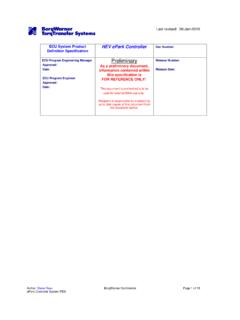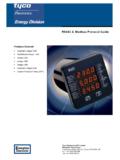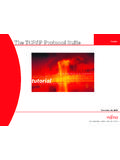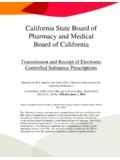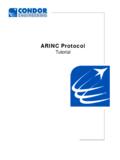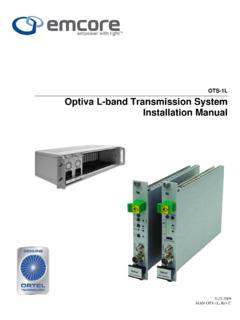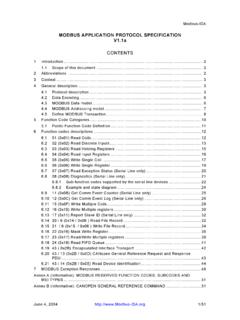Transcription of LIN (Local Interconnected Network)
1 Slide 1 2004. Vector Informatik GmbH. All rights reserved. Any distribution or copying is subject to prior written approval by 2004-12-0302_Fundamentals of the LIN ( local Interconnected Network) Fundamentals of the LIN ProtocolRalf Ralf SchweringSchwering, Software Development Engineer, Software Development EngineerVector Vector Informatik Informatik Slide 2 2004-12-0302_Fundamentals of the LIN 2004. Vector Informatik GmbH. All rights reserved. Any distribution or copying is subject to prior written approval by Communication Principle Message Format Scheduling Message Types Data Assurance Miscellaneous Slide 3 2004-12-0302_Fundamentals of the LIN 2004.
2 Vector Informatik GmbH. All rights reserved. Any distribution or copying is subject to prior written approval by Controlled Message Distribution System LIN nodes do not have equal access to the bus due to Master-Slave architecture LIN Master delegates communication (Delegated Token Principle) Message distribution based on message addressing 64 message addresses (Identifiers)ScheduleScheduleScheduleSch eduleLIN-BusScheduleScheduleTokenLIN-Sla veLIN-SlaveLIN-SlaveSlaveTask 2 Data4 Data3 SlaveTask 3 Data6 Data5 SlaveTask 4 Data8 Data7 SlaveTask 1 Data2 Data1 MasterTaskLIN MasterScheduleScheduleScheduleScheduleLI N-BusScheduleScheduleTokenLIN-SlaveLIN-S laveLIN-SlaveSlave-TaskDatenDatenSlave-T askDatenDatenSlave-TaskDatenDatenSlave-T askDatenDatenMaster-TaskLIN MasterScheduleScheduleScheduleScheduleLI N-BusScheduleScheduleTokenLIN-SlaveLIN-S laveSlave-TaskDatenDatenSlave-TaskDatenD atenSlave-TaskDatenDatenSlave-TaskDatenD atenMaster-TaskDatenLIN
3 MessageScheduleScheduleScheduleScheduleL IN BusScheduleScheduleTokenLIN-SlaveSlaveTa sk 2 Data4 Data3 SlaveTask 3 Data6 Data5 SlaveTask 4 Data8 Data7 SlaveTask 1 Data2 Data1 MasterTaskDataProducerConsumerConsumer The LIN network is based on a Master-Slave architecture. One network node is chosen to control all communication. This is the LIN Master. The LIN Master performs the role of a bus arbiter with the help of the so-called Master Task and LIN Schedule . The LIN Schedule sets the send time point of the LIN message to be transmitted. According to the LIN Schedule, the LIN Master places special messages referred to as Tokens on the bus at specified time points.
4 A Token can be understood as a Request, and it contains a message address. This is evaluated by the LIN Slaves. A LIN Slave has three alternatives for reacting to the Token: Send data, receive data, ignore data. Token and data together are referred to as the LIN message. Up to 64 LIN messages may be defined. Because of its message addressing method, each LIN message is available to be received by any LIN node even by the LIN Master if it has a Slave Task. The LIN network is therefore a centrally-controlled message distribution system. Slide 4 2004-12-0302_Fundamentals of the LIN 2004.
5 Vector Informatik GmbH. All rights reserved. Any distribution or copying is subject to prior written approval by Communication Principle Message Format Scheduling Message Types Data Assurance Miscellaneous Slide 5 2004-12-0302_Fundamentals of the LIN 2004. Vector Informatik GmbH. All rights reserved. Any distribution or copying is subject to prior written approval by Header The Token is referred to as the Message Header The Message Header is sent by the Master Task The Message Header is used for synchronization The Message Header includes the identifierTSYNBRKSync BreakTDEL0x55 Sync FieldMessage Header(at least 13 bits)Protected Identifier (PID) The Token is referred to as the Message Header in a LIN network .
6 The entire Message Header is transmitted by the LIN Master. It is made up of the Sync Break, Sync Field and PID (Protected Identifier). Both the Sync Field and Sync Byte are used for initial synchronization. The PID is comprised of the message address (Identifier) and two parity bits. According to the message address the LIN nodes decide what they do immediately after the Message Header (send, receive or ignore the message response). Slide 6 2004-12-0302_Fundamentals of the LIN 2004. Vector Informatik GmbH. All rights reserved. Any distribution or copying is subject to prior written approval by ResponseMessage ResponseData Byte nData Byte Field (max.)
7 8 Byte) The Message Response is sent by a Slave Task The Message Response is comprised of the data and checksum Classic checksum over data field (LIN ) Enhanced checksum over data field and ID field (LIN ) The message response is sent by a Slave-Task delegated for this purpose based on the message address. A maximum of eight data bytes may be transmitted with a message response. It should be noted that byte transmission begins with the LSB. Transmitting a word the transmission begins with the low byte (Little Endian transmission, Intel mode). In principle a message response may be received and accepted by all Slaves-Tasks.
8 The data bytes are protected with the help of a checksum. Checksum formation is based on Modulo-2 arithmetic and Carry Bit over all data bytes. The individual data bytes are added by Modulo-2 arithmetic. Overflow bits are carried. Finally the result is inverted. Two different checksums exist: Classic and Enhanced checksums. With the Classic checksum only the data bytes are protected. With the Enhanced checksum the data bytes and the identifier are protected. For LIN conformant LIN nodes the message responses to be transmitted are always equipped with the Classic checksum, since the Enhanced checksum is unknown in LIN It should be noted that LIN messages with identifiers 60 and 61 (Diagnostics) are always protected with the Classic checksum.
9 Slide 7 2004-12-0302_Fundamentals of the LIN 2004. Vector Informatik GmbH. All rights reserved. Any distribution or copying is subject to prior written approval by Flow Charts Slide 8 2004-12-0302_Fundamentals of the LIN 2004. Vector Informatik GmbH. All rights reserved. Any distribution or copying is subject to prior written approval by Message (Nominal) tHeader_Nom=(NSync_Field+ NSync_Byte+ NPID_Byte) tBit= 34 tBit tResponse_Nom= 10 (NData+ 1) tBit tFrame_Nom=tHeader_Nom+ tResponse_Nom14 Bit10 BitSync BreakData 1 Data HeaderMessage ResponseLIN MessageSyncFieldPID Field10 Bit10 Bit10 - 80 BittHeader_NomtResponse_NomtFrame_Nom The LIN message is made up of the Message Header and Message Response.
10 The Message Header is always sent by the LIN Master. It contains synchronization information (Sync Field and Sync Byte), the message address and two parity bits (Protected Identifier - PID). The Message Response contains a maximum of eight data bytes and a checksum. LIN message transmission is based on the SCI interface. A SCI character is made up of eight data bits framed by a start bit and a stop bit. If the Sync Break must be 13 dominant bits and be terminated by a recessive bit, then the LIN Message Header has a nominal length of 34 bits. The length of the Message Response includes the number of data bytes and the checksum: Min.
